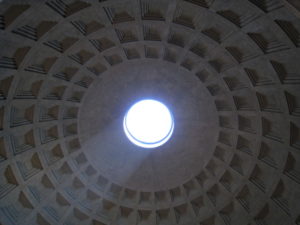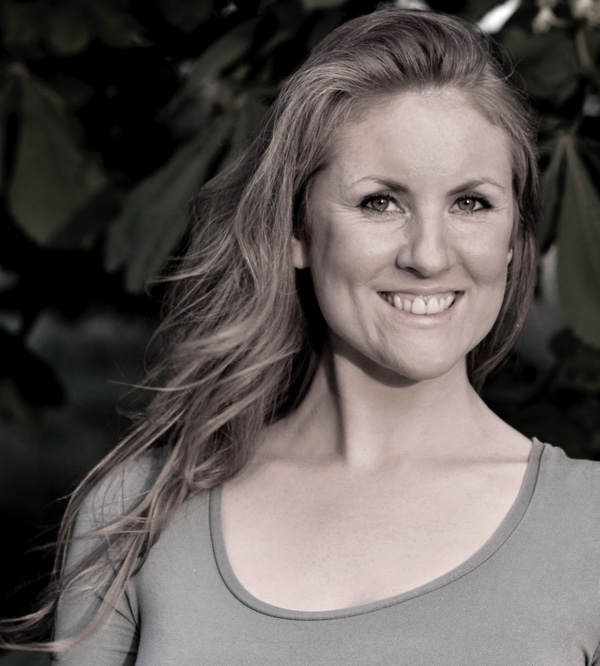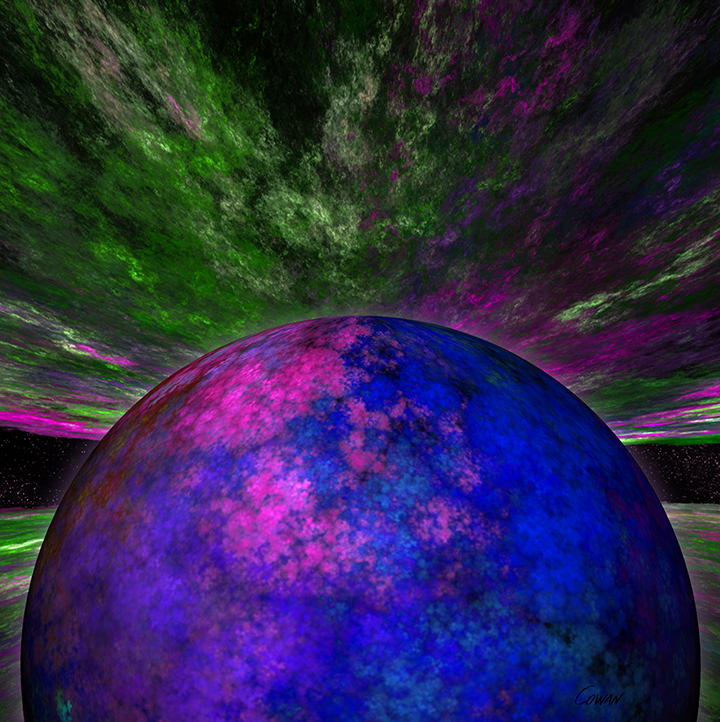U.K. artist, presenter and lucid dreamer, Caroline McCready speaks with interviewer Robert Waggoner about exploring conceptual boundaries through lucid dreaming.
How did you become interested in lucid dreaming?
I used to have spontaneous lucid dreams as a child, and most often I would use the dreams to go flying over Lake Louise in Canada near where my Dad grew up or I would simply examine the amazing realism of the dream environment I was in. As I grew up these experiences became more sporadic and the experiences became briefer, quickly fading and dissolving into non-lucid dreams.
A few years ago my dreams became extraordinarily vivid and I felt compelled to write them down every morning, so I started to keep a dream journal, which I hadn‘t done since my early teens. A sequence of synchronicities led me to a dream analysis group in London run by Debbie Winterbourne, who used to work with Stephen La Berge. I mentioned my early lucid experiences and as well as talking about some of her own amazing lucid adventures, she gave me techniques to induce and prolong lucid dreams. Before this point I‘d had no idea you could actually induce lucid dreams and was totally ignorant of the unbelievable potential for exploration within the dreams.
I was so excited and couldn‘t wait to fly over Lake Louise again. I started to read and listen to everything I could relating to lucid dreaming. I started to constantly question my reality and within 2 weeks I had an epic lucid dream which was the beginning of 2 solid months of one or more lucid experiences almost every morning. It was like opening the flood gates and starting a double life.
What do you recall of your first lucid dream/s? Anything odd, unusual, or unexpected?
The first lucid dream I remember as a child, I was in a small room playing pool with my cousin. I used to have a recurring dream when I was really young where I‘m in a room that‘s completely white. White walls, ceilings and floor, it‘s almost blinding. I‘m playing alone in the room, bouncing a ball around. There‘s nothing at all in this room apart from a trap door in the centre of the room and each time I had this dream the ball would always fall through this trap door and I would have to go and retrieve it. As I descended into the room below I would always find myself in a giant pool hall with rows and rows of pool tables and a large monster that looked a bit like the Gruffalo. I would have to cleverly dodge and hide from him as I fearfully searched for my bouncy ball. I think the pool table ignited that spark of lucidity and I can remember being in absolute wonderment of how unbelievably real the dream was. I could feel the hard, smooth pool balls. I could hear them click together as they hit each other and I could feel the soft felt on the table, which was a vivid and vibrant green.
What did you make of that?
I was in absolute awe, the space was so absolutely three dimensional and I had all of my faculties, but I didn‘t realize the potential of the experience until a dream soon after. I had been watching Superman (the first Christopher Reeve version) the day before. In the dream I was in my garden when I realized I was dreaming. I then thought of the scene where Superman takes Lois Lane flying and lo and behold a Superman swooped in and lifted me high above my garden and I still remember looking down, watching my garden swing get smaller and smaller as we flew higher. That was the first of many flying dreams. At the time I thought it couldn‟t get better than that!
What about lucid dreaming caught your interest and attention? What made you want to have another lucid dream and pursue it further?
It was so magical being in a dream space and aware of it, able to fly and for it to feel so amazingly real. I think anyone would want to recreate that. When I revisited lucid dreaming as an adult my initial motivation was simply to fly again in my dreams. Something completely unexpected happened though when I opened those flood gates and I was taken on a journey I couldn‘t have imagined. I was shown things about myself and the nature of reality that have completely changed my perspective about everything.
When you become lucid, does it result from a particular induction or incubation technique? Or have you simply trained yourself to notice the unusual when dreaming?
I find meditation, general mindfulness and frequent reality questioning is really effective. I like to transition directly from a waking state to a dream state so I find the wake back to bed method combined with meditation and affirmations very powerful. I tend to focus on hypnogogic imagery until they form into dream scenes and then step directly into the dream that way. If I‘m unsuccessful and lose consciousness then a common dream sign for me is that I‘m in a room with no doors and the windows don‘t open, so the only way to get out is to realize I‘m dreaming and walk through the wall or fly through a window.
You have some fascinating examples of your paintings and sculptures at your website www.carolinemccready.com. Does your training as an artist assist you in becoming lucid? (For example, you might notice strange details in the visual setting, and conclude, “Oh, this is a dream!”)
I think being visually aware is definitely helpful. The period I mentioned earlier where my dreams became incredibly vivid was a time when I was prolifically painting and not doing much else, as I was beavering away at a couple of commissions I needed to get finished. My paintings are very meditative and the process of painting for me is a visual, moving meditation. I think that really helped me to become lucid and maintain very prolonged and vivid lucid dreams as I was experiencing heightened focus and long periods of pure present moment awareness.
Because some of your artwork has to do with the nature of motion and the passage of time, have you ever played with these ideas in lucid dreams? Occasionally, some lucid dreamers mention „re-winding‟ the lucid dream to a portion they want to review, or freezing the lucid dream to examine that specific moment. While other lucid dreamers report playing with time by suggesting that they experience the past (even the past before their birth) or future. So have you used lucid dreaming to play with time and movement? What happened?
I have had a lucid dream where I commanded that everything pause and then I explored the frozen people and objects before setting the dream back in motion, which was a surreal and fun experience.
I had another dream where I was shown the life I thought I wanted at the time. It was like a projected fast forward reality. I had the absolute awareness of the future version of me. I looked, acted and felt like this older version of me. I looked down and I could physically feel my middle aged body as my own. I felt my future emotions and thought my future thought. Everything had panned out the way I wanted at the time and I realized by the end of the dream that it had bored me out of my brain and it wasn‘t actually what I wanted at all! It made me totally rethink some of my goals and wishes. It also made me more fearless about pursuing an alternative career path that feeds my passions and my soul without fitting into societal norms and other people expectations.
In the coming month, you and I will be offering a workshop in London, “Exploring the Healing Potential of Lucid Dreaming.” Have you personally used lucid dreaming as a means for emotional or physical healing? If you would, please share an example of your own, or if you prefer, someone else.
I have found that dreams naturally bring to the surface anything that needs healing or bringing into balance. This could be (often unrecognized) subconscious fears, suppressed emotions or limiting beliefs. The root causes of many emotional, physical or mental limitations are simply aspects of ourselves we don‘t fully love or accept and these aspects come to us as ‘shadow’ aspects in dreams. Lucid dreaming is a wonderful tool to integrate these elements and cast light into the shadow with profound effects. Without always intending to I‘ve often stumbled across subconscious limitations I wasn‘t aware of by chance and used ‘shadow integration’ techniques to heal these.
It‘s also possible to use dreams for direct physical healing and I‘d like to share a powerful lucid dream experienced by my friend Tereza Griffin, who comes to my lucid dream groups:
In the dream she found herself looking at a horse and she went into the horse‘s eye, seeing the whole structure of the veins and the eye closely. She then became the horse and subsequently transformed back into her human form. She went inside her body and was experiencing everything as a point of awareness. She wanted to heal her knee (which in waking reality gives her a lot of pain) and so took her awareness down into the left knee. She saw what looked like ‘lots of black platelets‘ and decided to ‘blast them with light’. She was able to fill the left side of the knee with light, but the right side remained dark.
How did they feel afterwards?
She then woke up and got out of bed. She started reading and then realized she was reading with her normal glasses not reading glasses. So she took them off and found she could see just as well without glasses for a full 10 minutes before her vision returned to normal. She then looked in a mirror and realized her lazy eye had also corrected itself slightly. She decided to check her knee. On the left knee where she has problems it is very indented due to loss of muscle, but to her delight, shock and awe realized there was more muscle there than before and feels that the dream had a lasting physical impact in a healing capacity on her knee a temporary effect on her eye-sight.
In a BBC story on lucid dreaming, you mention: “I’ve come to understand a lot of my fears now because I’m able to confront them directly in dreams.” What is it about lucid dreaming that allows someone to do this? Did you intend to find out your fears? Or did the fear just appear in the lucid dream, and then you had to respond?
I‘ve never really gone looking for fears in dreams and always felt confident and fairly fearless on a conscious level, so in experiences where I‘ve been confronted by fears, it‘s been quite a surprise to me.
In one dream, without any intention of seeking or uncovering a fear, I simply said to the dream ‘show me something important‘. I found myself at the mouth of a dark tunnel, feeling terrified, I could sense that there was something gruesomely menacing in this tunnel, but I was being drawn forcibly into the tunnel, unable to do anything other than continue moving forward. As I turned a corner I was confronted by an enormous and grotesque shadowy figure, like something from a horror film. I was told by the dream that this shadow figure was my fear of death. It was so horrifying that I woke myself up, but ended up in a false awakening with this shadow figure lying completely realistically beside me. I was unable to move, paralyzed by fear, with this figure breathing heavily down my neck with terrible breath and a husky gurgling rasp in his throat. I went through another false awakening before finally waking up. The fright wore off almost instantly and I was frustrated with myself for running rather than embracing this challenge.
The next morning I went straight from a waking meditation into a lucid dream and asked to be taken to my fear. I felt myself being pulled down and although I was initially frightened by the prospect of facing this figure once more I was able to transform my fear into resignation and acceptance. I felt myself open my arms and feel ready to face anything…the moment I did that the direction I was being pulled changed. I was no longer being dragged down, but instead lifted into a glorious sky with white clouds on one side and dark clouds on the other. They were all lined and bathed in gold light and I began to feel every cell in my body vibrate with indescribable, pure, ecstatic bliss. It was so beautiful I cried when I woke up.
What advice would you give someone who stumbles upon a fear, whilst lucid dreaming? And what do you learn in the process of these lucid dream healings that help you in the waking state for more lucid living?
The advice I‘d give is absolutely to face and embrace it within the dream in whatever form it comes. As soon as a fear is truly embraced it is immediately transformed, which can be life changing. As with the experience I mentioned above, I didn‘t even have to face the figure representing my fear of death in the second dream. As soon as I had made the transition to acceptance I underwent an unimaginably beautiful experience instead.
While I hadn‘t consciously been aware that I was afraid of death, I noticed I was more fearless about everything after that experience. I was less concerned with other people‘s concerns and judgment about me and less afraid to do what I really wanted to do. Some people observe that the root cause underlying all fear is the fear of death and I really believe that that dream helped me to become more fearless in every aspect of life and truly grab my life by the horns.
Many lucid dreamers wonder if dreaming and lucid dreaming merely show us the reflections of our conscious mind. The last time I visited London, you told me about a fascinating lucid dream, where you explored this quandary. What did you do in the lucid dream to get beyond the conscious mind?
There is a technique that was taught to me by Charlie Morley, who teaches lucid dreaming in London. If you preface or follow a question with ‘beyond my projections‘, that can take you beyond your subconscious filters, projections and reflections.
For example I was in a lucid dream scene when I shouted to the sky ‘show me the consciousness that is beyond my projections’. I was instantly sucked up through the universe and all around me the planets and the stars were shown to me as balls of pure light and consciousness. There was no matter, just light and the light was consciousness itself. This felt so physically real that it still gives me goose bumps thinking about it. As I hurtled through space a male voice was repeating over and over ‘the micro is the same as the macro’.
I went beyond the ‘edge’ of our universe and was surrounded by orbs of pure conscious light which were much more densely concentrated consciousness than the planets and stars. As I went higher and higher the orbs of light became more and more prevalent until there were so many that they were starting to fuse together emitting more and more light. It was truly beautiful. Above me there was nothing but pure light and unified consciousness.
An amazing lucid dream! So how did you take this? Or what did it mean to you?
I had an instantaneous block of information downloaded into my awareness within the dream that what I was being shown were other universes in an infinite sea of parallel universes, and that our universe is like a cell and that these orbs of light beyond our universe were like cells/universes in an infinite mega-verse.
I was shown that each galaxy is comparable a molecule within a cell, that solar systems are similar to atoms, that Suns are like nuclei within an atom, planets are like electrons orbiting the atom and that we are like quarks and that each decision we make causes cell division creating more universes and that it is a similar process that causes cell division in physical ‘reality’…that the different outcomes of each quark’s decisions are played out in different cells and that each cell within biology, for instance within a human being, each cell is like a universe playing out a slightly different parallel reality in an enormous mega-verse.
I was shown in the dream that this is the instigating cause of cell division. So each of us is like a mega-verse, each organ in like a system of multiverses. So each quark is pure consciousness, each electron is a collective consciousness, each cell is a collective consciousness, each organ is a collective consciousness of the cells it contains and we are a collective consciousness of all of our organs and all of the individual consciousness‘s within those organs as well as our individual soul which inhabits this housing of consciousness‘s.
I believe some of our readers will think about quantum physics and string theory, when they read this. Does that connect with your thinking, and do you wonder if talented lucid dreamers could use lucid dreaming as a tool to explore the ideas of modern physics and the nature of reality?
I‘ve been fascinated by string theory. Einstein was always searching for a unified theory of everything that explained/unified the seeming differences between the macro physical laws like gravity and electromagnetism with the seemingly strange and illogical laws of the quantum world. Ever since Einstein physicists have searched for this unifying theory. String theory seemed to be the long awaited answer. By adding extra theoretical dimensions of space, observing ten in total, everything seemed to make sense. However there were several conflicting versions of the theory and they could never quite get all of the formulae to add up.
The most current theory is M-theory, where finally all the formulae add up and it does seemingly unify the laws of quantum physics and macro physics. The theory suggests that all sub-atomic matter in the Universe is connected by and consists of a giant membrane of energy. There are infinite parallel universes where every conceivable version of you exists (as well as infinite universes where you don‘t exists) and all of these parallel universes float around in 11th dimensional space and some people suggest that they float around like balls in the 11th dimension. So by adding an extra 11th dimension to string theory, in which infinite parallel universes exist, they have achieved the unified theory everyone has been searching for since the discovery of the strangeness of the quantum world.
I didn‘t read/hear about that until about 9 months after the dream, so it feels as though I was being shown the fundamental principles of M-theory long before I was consciously or subconsciously exposed to them in waking reality. It feels that the dream was not only showing me the principles of M-theory but also relating them to the various microcosms within our bodies, so I absolutely think that lucid dreaming has the potential to answer questions about the nature of reality.
You briefly touched upon the idea of interacting with a larger awareness in lucid dreams, or what I call the awareness behind the dream. What type of lucid dream experiments or questions have you posed to that awareness?
I had an unexpected experience relating to time when I shouted to the larger awareness ‘beyond my projections, show me my multidimensional nature’… the dream split in to many layers and I was shown dozens of lives I‘m living simultaneously. These included lives from different time periods, that we would consider ‘past-lives’ as well as future lives. The dream was showing me that the past, present and future all exists in the present moment and time flows in all directions. This non-linear nature of time is something that quantum physicists know on a theoretical level, but it‘s difficult to imagine or feel without direct experience.
In other issues of LDE, we have had interviews and articles on lucid dreamers accessing unknown information in lucid dreams. Have you had lucid dreams that seemed to provide you unknown information that you later validated?
I had an interesting experience when a dream figure told me to eat more eggs to help improve my lucid dreams. The next day I stumbled across a YouTube video about Choline Bitartrate as a natural supplement to improve the frequency of lucid dreams as well as recall, which is found naturally in egg yolks.
I also feel that the dream I mentioned earlier where I shouted ‘show me the consciousness that is beyond my projections‘ was showing me the principles of M-theory, which I wasn‘t aware of until about 9 months after the dream.
I also often experience what I call ‘next-day residue’, which is like day residue, where you get the day‘s events weaving into your dreams, but it is events from the day after the dream as opposed to the day before that are seeping into the dream.
Looking forward, what areas would you like to explore through lucid dreaming?
I certainly hope to explore healing, the nature of consciousness, void space and the nature of the connection that underlies and unites all things more. I always find that the most profound experiences occur when I go with the flow and allow the dream to take the lead and show me what it want to see. So without trying to control it too much I look forward to continuing the journey and seeing where it takes me. Lucid dreaming feels like a limitless and exciting adventure.








